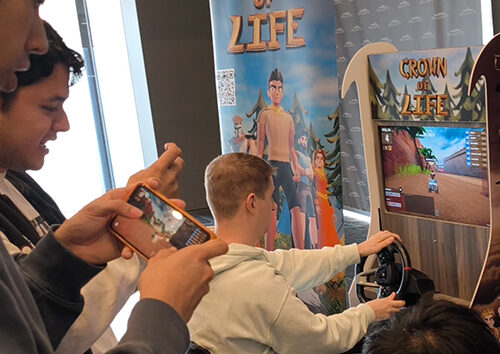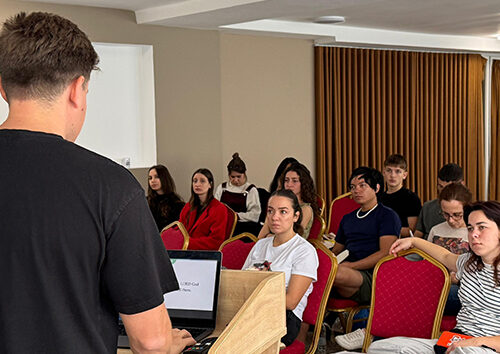Presented by Sigve Tonstad
22 August, 2012 Rogaška Slatina, Slovenia [John Surridge, tedNEWS] In the first of six in depth presentations by Adventist specialists from around the world, Dr Sigve Tonstad from Loma Linda University, USA gave the one thousand assembled European pastors a unique insight into the story of the woman of Samaria as recorded in John chapter 4.
Dr Tonstad’s approach was disarmingly relaxed at first. Using careful exposition he went through the story, highlighting the known facts and introducing the pastors to a few ideas they may not have thought of. However it soon became clear that what was being presented was not simply exposition, it was an object lesson for all pastors who seek to make God known in the 21st century.
Dr Tonstad began by pointing out that the text begins from a position of tension. The Pharisees were keeping tabs on what Jesus was doing, and in return Jesus was keeping an apprehensive eye on them. As a result Jesus retreated from Judea to Galilee, and, the text says, “he had to go through Samaria”. But was this a geographic necessity? Probably not, said Dr Tonstad. In fact Jesus’ visit to Samaria was probably part of His plan – an intentional plan to reach lost people.
The next part of the story was illustrated by a literal “woman at the well” – on the stage, with a bucket! The story of Jesus’ conversation with this woman may be quick to read, said Dr Tonstad, but in “real time” it no doubt took a lot longer. After taking a leisurely real drink from a real glass, Dr Tonstad told the pastors that they needed to be careful not to rush through stories like this. In actuality, Jesus must have been engaged in a number of confidence building exercises where he skillfully used small talk, eye contact, and other important forms of communication, both verbal and non-verbal to break down the barriers that existed between Him and the woman. Three of the barriers evident in the text: socio-ethnic, gender and moral, still challenge us today.
With the barriers broken down and a level of trust established, Jesus moved the conversation on from His need to her need. He spoke generally at first but then moved from the sublime (living water) to the specific (go and get your husband).
This abrupt transition in the conversation must have been a shock to the woman, said Dr Tonstad, but not as much of a shock as when she found out that Jesus knew intimate details about her private life! John records the facts in precise detail – and perhaps there’s a lesson for pastors here. It’s possible that Jesus knew the facts by divine revelation but it’s also possible that He picked up the information from local sources – perhaps the Samarian “gossip columns”. Do we as pastors care enough about people to really find out about them?
 In many cases Jesus’ direct approach could have been a conversation stopper, but it is the way that Jesus managed the transition that is key, said Dr Tonstad. Through tact, insight and an understanding of her situation, Jesus leads the woman along a progressive path of understanding: first she sees Him as an exceptional human being, then as someone who might possibly be greater than Jacob, then a prophet, but finally the Messiah.
In many cases Jesus’ direct approach could have been a conversation stopper, but it is the way that Jesus managed the transition that is key, said Dr Tonstad. Through tact, insight and an understanding of her situation, Jesus leads the woman along a progressive path of understanding: first she sees Him as an exceptional human being, then as someone who might possibly be greater than Jacob, then a prophet, but finally the Messiah.
The story ends with a powerful witness: “Come and meet a man who told me everything I ever did?” From being ashamed of her past, coming out alone to the well so that she wouldn’t have to confront the painful parts of her life, the woman is transformed. Jesus has “detoxified” her relational history. “Now she knows,” said Dr Tonstad, “that something which was wrong can be made right.”
Dr Tonstad concluded his presentation with five points that specifically apply to ministers today:
1. The woman of Samaria was reached by a ministry that was local, personal and individual. You won’t reach this kind of person through TV evangelism.
2. In the gospel of John the role of women in ministry is so conspicuous that you wonder why we are still having discussions about it today!
3. To the disciples Samaria was simply a “gas station” – a place where you could get essential provisions but then move on. They couldn’t understand why Jesus would be interested in a woman from such a place. Are we missing such places in our ministry today?
4. Jesus went to great lengths to win the woman’s confidence before He went on to spiritual matters. Are we keen observers and good listeners?
5. The story tells us about need and longing. The woman needed and longed for the living water that Jesus talked about. As we read the story however we come to realize that Jesus too had a great need and a great longing – not for water but for the woman’s salvation. As the incarnate Son of God, Jesus’ actions reveal something even deeper about the Father. Our need of God may be deep – as deep as a well, but His need, his longing, to save us, is bottomless. [tedNEWS]
tedNEWS Staff: Miroslav Pujic, director; Deana Stojkovic, editor; Dragana Selakovic-Duval, Frederic Duval & Tor Tjeransen, photographers
119 St Peter’s Street, St Albans, Herts, AL1 3EY, England
E-mail: [email protected]
Website: www.ted-adventist.org
tedNEWS is an information bulletin issued by the communication department of the Seventh-day Adventist Church in the Trans-European Division.
You are free to re-print any portion of the bulletin without need for special permission. However, we kindly request that you identify tedNEWS whenever you publish these materials.


